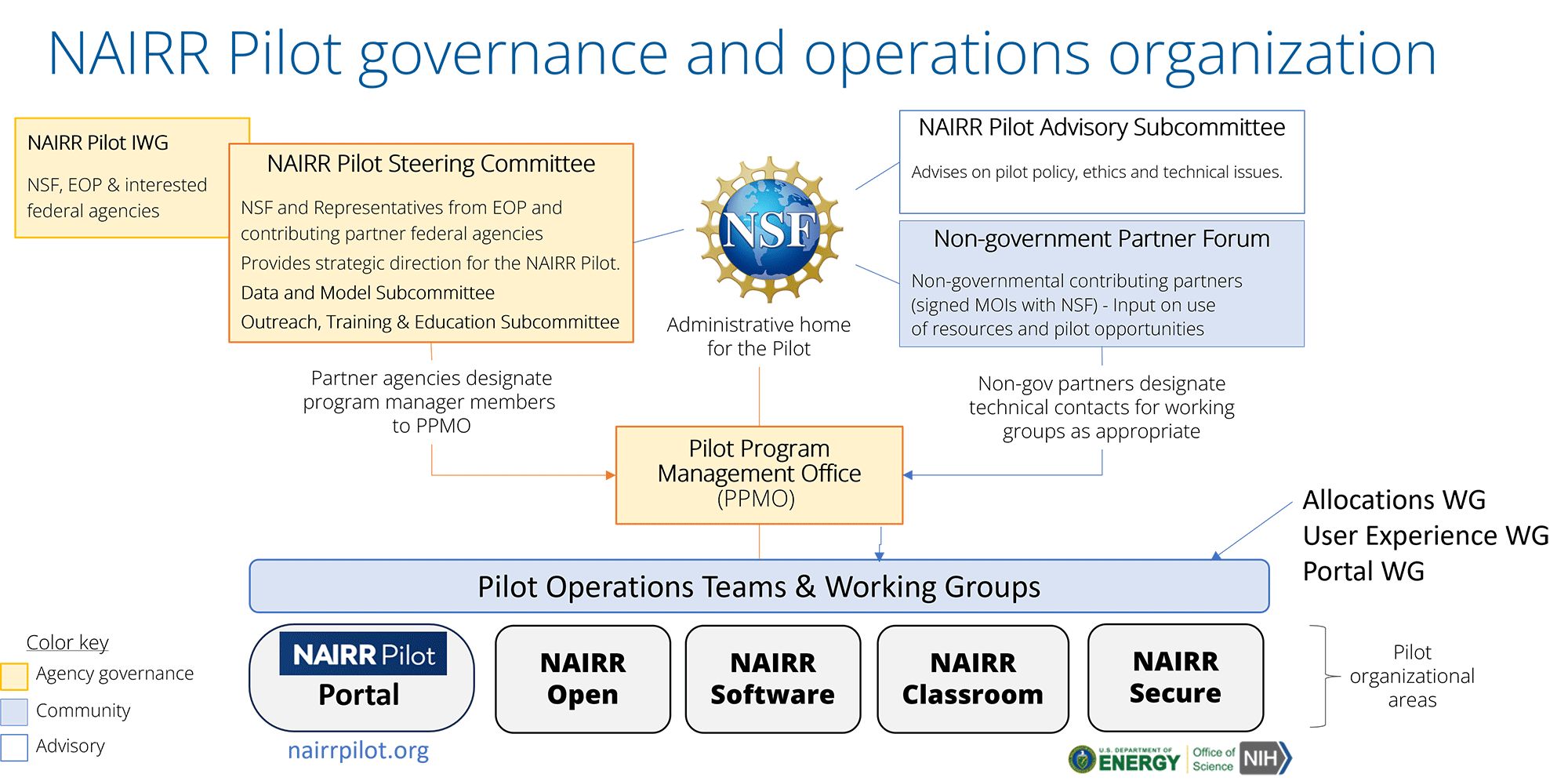About NAIRR Pilot
What is the NAIRR?
AI holds the potential to accelerate discovery and innovation and help solve critical societal and global challenges. However, many researchers lack the necessary access to the AI resources needed to fully conduct their research activities and to train the next generation of researchers. The National Artificial Intelligence Research Resource (NAIRR) is a concept for a shared national research infrastructure to bridge this gap by connecting U.S. researchers to responsible and trustworthy Artificial Intelligence (AI) resources, as well as the needed computational, data, software, training, and educational resources to advance research, discovery, and innovation. The aim is to ensure that AI resources and tools are equitably accessible to the broad research and education communities in a manner that advances trustworthy AI and protects privacy, civil rights, and civil liberties.
What is the NAIRR Pilot?
The purpose of the NAIRR Pilot is to demonstrate the NAIRR concept and advance its main goals, namely to: spur innovation, increase diversity of talent, improve capacity, and advance safe, secure, and trustworthy AI in research and society. The NAIRR Pilot aims to address researcher needs by increasing access to a diverse ensemble of AI-related infrastructure resources including computational capabilities, AI-ready datasets, pre-trained models, software systems and platforms. This is an iterative process, beginning with the initial launch of the NAIRR Pilot in January 2024. In its first Phase, the NAIRR Pilot is providing researchers and educators with:
- The ability to apply for access to advanced computing, software, platforms, and collaborations for AI research and education.
- Access to a growing list of contributed AI-specific resources, such as pre-trained models, AI-ready datasets, and relevant platforms.
More background on the first phase of the NAIRR Pilot and engagement mechanisms for your research communities can be found at the following NSF webinar recording held February 21, 2024. The NAIRR Pilot will continue to bring together government-supported and non-governmental contributed resources in phases over a two year period to demonstrate the NAIRR concept and to deliver early capabilities to the U.S. research and education community.
What has informed the vision for the NAIRR and the NAIRR pilot?
The NAIRR Pilot is informed by an implementation plan for the NAIRR produced in January 2023 by a task force co-chaired by NSF and the White House Office of Science and Technology Policy. As a first step toward realizing that vision, guided by President Biden’s Executive Order 14110 in October 2023 on Safe, Secure and Trustworthy Development and Use of AI, NSF and other federal agencies are now collaborating on a Pilot implementation of the NAIRR over the next several years.
For more information about this effort, please visit the NSF-hosted NAIRR Pilot website. Questions can be sent to NAIRR_Pilot@nsf.gov
NAIRR Pilot Management and Governance
Following the recommendations of the NAIRR Task Force, the NAIRR Pilot has implemented the following management and governance structure. Learn more about the NAIRR Pilot Management and Governance.

How to Acknowledge NAIRR
When you publish your research based on the use of NAIRR pilot-provided resources, please include following language in your acknowledgments (including resource specific snippet provided in the table below, as appropriate).
This research is supported by the National Artificial Intelligence Research Resource (NAIRR) Pilot and [AWARDED-RESOURCE-ACK]
| Resource | AWARDED-RESOURCE-ACK |
|---|---|
| ACES | the ACES system supported by the National Science Foundation (award NSF-OAC 2112356) at the Texas A&M High Performance Research Computing (HPRC). |
| ANL AI Testbed | the Argonne National Lab AI Testbed at the Argonne Leadership Computing Facility, a U.S. Department of Energy (DOE) Office of Science user facility at Argonne National Laboratory and is based on research supported by the U.S. DOE Office of Science-Advanced Scientific Computing Research Program, under Contract No. DE-AC02-06CH11357. |
| Anvil | the Anvil supercomputer supported by the National Science Foundation (award NSF-OAC 2005632) at Purdue University. |
| Bridges-2 | the Bridges-2 system, which is supported by NSF award number OAC-1928147 at the Pittsburgh Supercomputing Center (PSC). Brown, S. T., Buitrago, P., Hanna, E., Sanielevici, S., Scibek, R., & Nystrom, N. A. (2021). Bridges-2: A Platform for Rapidly-Evolving and Data Intensive Research. In Practice and Experience in Advanced Research Computing (pp. 1-4). doi: 10.1145/3437359.3465593 |
| Delta | the Delta advanced computing and data resource which is supported by the National Science Foundation (award NSF-OAC 2005572). |
| Frontera/Lonestar | the Frontera supercomputer supported by the National Science Foundation (award NSF-OAC 1818253) at the Texas Advanced Computing Center (TACC) at The University of Texas at Austin. |
| Jetstream2 | the Jetstream2 cloud resource supported by the National Science Foundation (award NSF-OAC 2005506) at Indiana University. https://jetstream-cloud.org/research/index.html#cite-jetstream |
| NeoCortex | the NeoCortex system supported by the National Science Foundation (award NSF-OAC 2005597) at the Pittsburgh Supercomputing Center, a joint computational research center with Carnegie Mellon University and the University of Pittsburgh. |
| Summit | the Summit supercomputer at Oak Ridge Leadership Computing Facility, a U.S. Department of Energy (DOE) Office of Science user facility at Oak Ridge National Laboratory, which is supported by the DOE Office of Science under Contract No. DE-AC05-00OR22725. |